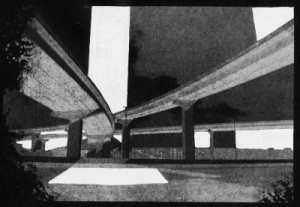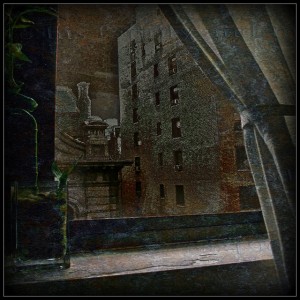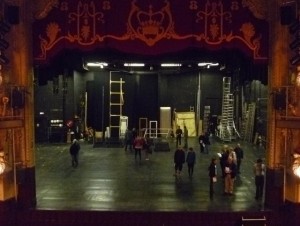 Now through April 28th the Orlando Museum of Art is hosting an exhibition titled The Aesthetics of Scale. The exhibit showcases the collaborative work of Rachel Simmons and Lee Lines and explores the ways in which landscape affects how people live in conjunction to the land. Perhaps more importantly, from an artistic perspective, the exhibit opens a discussion about artistic collaboration and what it offers to those willing to pick up its admittedly unwieldy mantle.
Now through April 28th the Orlando Museum of Art is hosting an exhibition titled The Aesthetics of Scale. The exhibit showcases the collaborative work of Rachel Simmons and Lee Lines and explores the ways in which landscape affects how people live in conjunction to the land. Perhaps more importantly, from an artistic perspective, the exhibit opens a discussion about artistic collaboration and what it offers to those willing to pick up its admittedly unwieldy mantle.
The project that would eventually lead to The Aesthetics of Scale started in 2010 during a research trip to Iceland. What was eventually born out of this trip was the marriage of Simmons’ artistic background and Lines’ knowledge of geography and environmental issues, a collaboration of not only academic goals but artistry.
This does not mean that the marriage of their backgrounds and intentions came together easily. In an interview conducted by Laura J. Cole for Rollins College, Lee and Simmons discussed a point of tension between the two over an image for a presentation. Simmons wanted to flip the image because she felt that it looked better aesthetically while Lee saw that as a misrepresentation of the regional landscape. Simmons was speaking from the artist’s point of view and was more concerned about how the piece spoke to its audience. On the other hand, Lee was looking at it from a geographer’s point of view and felt that repositioning the piece was dishonest from a scientific standpoint.
 Here, in the variance of vision, is where collaborations like this so often fall apart. These differences in artistic direction are likely to pile up and can easily have the capability to either destroy the project completely or just pull it towards a weaker middle where neither artist’s vision is fully realized. Art is, after all, to be done in one’s loft in total secrecy and seclusion until gallery opening or publication.
Here, in the variance of vision, is where collaborations like this so often fall apart. These differences in artistic direction are likely to pile up and can easily have the capability to either destroy the project completely or just pull it towards a weaker middle where neither artist’s vision is fully realized. Art is, after all, to be done in one’s loft in total secrecy and seclusion until gallery opening or publication.
And this is the opinion I had for a long time. Having been an artist earlier in life and now, as a writer, I knew the value of working in an environment free from distractions. Another artist who might question your decisions or vision certainly has to number extremely high on the chart of distractors.
While that need for seclusion is still strong and one that I find necessary a great deal of the time, something changed for me recently and I no longer feel that sequestering oneself is a hard and fast rule. The first step was realizing the value of another artist’s opinion. This began by using family and friends in the artistic community as sounding boards. This practice was broadened during my exposure to writing workshops. Granted not everything you hear from either group will crack open your work, but by listening to others’ perspectives you may begin to understand how your work appears to your audience, something which is certainly invaluable. Whether this newly shifted perspective on your work means a change in the work itself or merely a change in how you see it working is entirely up to you.
 The second big break came when I started to become involved in theater. Here is an art form where artistic collaboration is an undeniable necessity. Actors, directors, lighting, media, and stage designers, and playwrights are all necessary for any given project. Each person involved has their own artistic vision for the piece they’re working on. It goes without saying that this often leads to creative differences and disagreements, but once you do you are more likely to end up with a piece which is more fully realized. What I’ve found is that, and partially because of artistic differences, you are left with a much stronger piece. In a well-functioning group, each artist will have had their input and that input will push the piece further than any one person might have been able to do alone.
The second big break came when I started to become involved in theater. Here is an art form where artistic collaboration is an undeniable necessity. Actors, directors, lighting, media, and stage designers, and playwrights are all necessary for any given project. Each person involved has their own artistic vision for the piece they’re working on. It goes without saying that this often leads to creative differences and disagreements, but once you do you are more likely to end up with a piece which is more fully realized. What I’ve found is that, and partially because of artistic differences, you are left with a much stronger piece. In a well-functioning group, each artist will have had their input and that input will push the piece further than any one person might have been able to do alone.
The interesting thing about collaboration is that it is not an event that happens terribly often in the artistic community and even less in the literary world. Obviously a lot of this has to do with the private nature of writing itself and how differently the craft operates from one writer to the next. This is disappointing because artistic collaboration seems to have such an interesting potential if for no other reason than expanding the understanding of craft for those involved. In her interview, Simmons said “there’s nothing like trying to understand the point of view of another academic discipline to help you understand your own.” Why should this be any different for the artistic community? Shouldn’t we, as artists, being doing all that we can in order to push our craft to the highest level possible? It seems that collaboration is just another step down the road to self-actualization for any artist.
The entire interview with Simmons and Lee can be found here.